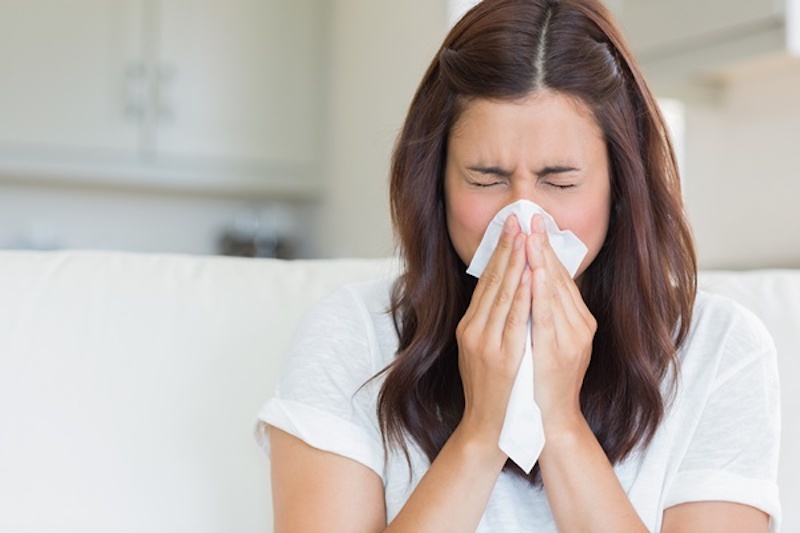Seasonal weather changes bring about an increase in respiratory infections, including common illnesses such as sore throat, pneumonia, and bronchitis. Those who haven’t experienced these conditions before can easily fall prey to them, while those currently suffering may see their conditions worsen, and those who have recovered may find themselves susceptible to a relapse. The following article will outline some of the most common respiratory illnesses and provide effective prevention methods.
1. Sore Throat
Sore throat is the most prevalent condition in the community, with various causes, primarily viruses and bacteria. There are three types of sore throat: pharyngitis, tonsillitis, and ulcerative pharyngitis. Any of these conditions can lead to headaches, throat pain, and pain when swallowing. Other symptoms may include a cold, nausea, body aches, swollen tonsils, and neck lymph node enlargement. The most dangerous type of sore throat is caused by Group A Streptococcus beta-hemolytic streptococci, which can lead to severe complications affecting the heart, joints, and kidneys.
Some characteristic signs of a sore throat caused by Group A Streptococcus include a high fever of 39-40 degrees Celsius, fatigue, white pus in the tonsillar fossae and crypts on both sides, and swollen submandibular lymph nodes that are painful to touch. To effectively prevent this condition, it is essential to keep your neck warm and maintain a nutritious diet to boost your immune system. Sore throat is highly contagious and can spread through direct or indirect contact. Therefore, if someone around you has a sore throat, it is best to avoid close contact and wear a mask.

For further reference: March 24th: Meaning and Theme
2. Acute Bronchitis
The causes of acute tracheobronchitis during the fall and winter seasons are typically influenza viruses, such as influenza A and B, parainfluenza viruses, and respiratory syncytial viruses.
The symptoms of upper respiratory tract infections often overlap with those of tracheobronchitis. Prevention mainly involves staying warm and avoiding the cold, and common antibiotics are used to treat secondary infections.
3. Bronchiectasis
There are two types of bronchiectasis: “dry” and “wet”. Wet bronchiectasis, or productive bronchiectasis, is characterized by excessive coughing and sputum production, usually due to bacterial infections. Fall and winter are the seasons when wet bronchiectasis is most prominent and has the highest incidence rate. Cold temperatures stimulate the bronchial secretion of mucus, which accumulates in the dilated bronchi, providing an ideal environment for bacterial growth. Therefore, special attention must be paid to preventing cold temperatures and bacterial infections during this season.

4. Cor Pulmonale
Cor Pulmonale, or pulmonary heart disease, is a heart condition caused by chronic lung disease (chronic bronchitis, asthma, bronchiectasis, emphysema, pulmonary tuberculosis, etc.). The cause of acute episodes is usually bacterial infection. The disease often worsens suddenly during the cold season, with patients experiencing shortness of breath, leading to hospitalization.
Although it is a heart condition, the treatment primarily focuses on the lungs and addressing the bacterial lung infection. While the progression from lung disease to heart disease can take a long time, the detection of cor pulmonale often occurs within a shorter timeframe. If left untreated, cor pulmonale can lead to respiratory failure and death. Therefore, preventing acute episodes of cor pulmonale during the cold season is a matter of life and death, and patients need to be aware of this to protect themselves effectively.
5. Asthma
The airways of asthmatic individuals are highly sensitive to various stimuli, including pollen, chemicals, biological dust, fungi, mold, bacteria, inorganic dust, and substances originating within the body, such as hormones and internal changes.
In asthma, the most critical condition to watch out for is status asthmaticus, which is common in young children and is mostly caused by allergies. Another form is continuous asthma, which can occur at the outset or after status asthmaticus and is often seen in patients with a long history of asthma. Other types include asthma with pneumothorax, which occurs in patients with emphysema, malignant asthma, aspirin-induced asthma (aspirin is commonly used during the fall and winter seasons to treat colds and fever), and asthma with accompanying hypertension…
To prevent asthma, it is essential to avoid cold temperatures, dust, parasites, mold, and pollen. Treatment must be swift and effective, aiming to stop asthma attacks in the shortest possible time and prevent them from turning malignant.

For further reference:
The above are some of the most common illnesses that occur during cold weather. We hope that you and your family will take the necessary precautions to stay healthy and avoid these unpleasant conditions.
What is the best time to drink lemon honey water? Be careful, it can be harmful to drink it at the wrong time.
In conclusion, the decision to drink honey lemon water in the morning or before bed is a personal one. While it may offer some potential health benefits, it’s important to approach it with a realistic mindset and not expect miracles. Remember, moderation is key when it comes to any dietary practice.




































